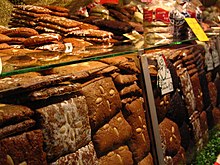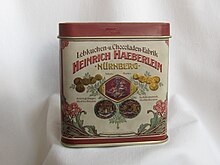Nuremberg gingerbread

Nürnberger Lebkuchen is a protected designation of origin for gingerbread from Nuremberg , which has been recognized as a protected geographical indication (g. G. A.) under European law since July 1, 1996 . Accordingly, only those gingerbread may be offered as "Nuremberg Lebkuchen" that were produced in the area of the city of Nuremberg. Additional requirements, such as a restriction to particular types of gingerbread or any quality criteria, are not associated with the term.
According to various sources, there should have been legally binding protection for the name since 1927, which has also been protected across the EU since 1995. The legal nature of this property right and more precise criteria are unknown. Since 1978 there has also been a non-legally binding entry as a geographical guarantee of origin (RAL-RG 0131) in the register of the RAL Institute .
history
The history of Nuremberg gingerbread is closely linked to the location of Nuremberg as the intersection of several European trade routes, which gave the city an economic heyday from 1470–1530 and brought the spices to Nuremberg from distant countries (see Lebkuchengewürz and " Pfeffersack "). There was also a well-developed Zeidler system here . The Zeidler won the honey with special rights from the Lorenzer Reichswald . However, the origins of Nuremberg gingerbread go back to this time. "Lebzelter" and "Lebküchner" are known from the 12th century, the first Lebküchner in Nuremberg is mentioned in a document or an account book in 1395. The monks are likely to have eaten the self-made, strong gingerbread, the nuns the sweeter "panis mellitus" according to a Roman recipe. Later, the Lebküchner guilds developed their own , and 14 members joined forces for the first time in Nuremberg in 1643. The history of the wafer gingerbread begins in Nuremberg with the "Elisenlebkuchen", which a manufacturer is likely to have named after his daughter Elisabeth.
During the Reichstag in 1487 , Emperor Friedrich III. During the week of the cross, the city's children come to the moat and distributed small gingerbread with his likeness on the occasion of the Reichstag. These were received with great enthusiasm. From then on in Nuremberg until the 18th and 19th In the 19th century, such “Kaiserlein” baked in several companies, from Lebkuchen-Schmidt to this day. In 1855 King Maximilian II and the Queen visited Nuremberg. In their honor, the gingerbread bakers baked the couple a giant gingerbread with the decoration “Heil our König”.
Nuremberg gingerbread also found its way into illustrated children's books. For example in the book Nürnberger Lebkuchen by Elsbeth Fehlberg with pictures by Lotte Schobert.
description
Nuremberg gingerbread is typically understood to mean large, mostly round wafer gingerbreads with sugar icing, with a chocolate coating ("chocolate-coated") or without a coating ("natural"), as well as the always square white gingerbread cookies, also baked on wafers. Often these wafer gingerbreads are also decorated with almonds and lemon peel. A special quality feature is a high proportion of almond and nut kernels and a small addition of flour or even the complete absence of it. Wafer gingerbread of the highest quality according to the German food book is called "Elisenlebkuchen" and occupy a prominent place in the assortment of practically all Nuremberg suppliers. They must have a particularly high-quality composition with at least 25% almonds, hazelnuts or walnuts, no other oil seeds and a maximum of 10% flour or 7.5% starch.
Apart from that, all other types of gingerbread such as honey cake , Printen or dominoes can be sold as Nuremberg gingerbread if they only come from Nuremberg, as it is purely a designation of origin. There are also no special quality standards associated with it. Therefore, with high-quality Nuremberg gingerbread, you will occasionally come across the corresponding protected labeling in accordance with the German Food Book together with the addition "Nuremberg", i.e. fine Nuremberg gingerbread or Nuremberg Elisen gingerbread .
Under the name “Lebkuchen-Bruch”, the manufacturers sell pieces that have passed the quality control of the respective company, for example because they are actually broken or damaged, but often only because they have an uneven shape, for example. In terms of taste, they are usually not inferior to regular goods. Lebkuchen-Bruch is mainly offered in stores in Nuremberg and other cities, but some manufacturers also sell it by mail order.
Manufacturers of Nuremberg gingerbread must produce within the city limits of Nuremberg. These are, for example, the Lambertz Group (brands Haeberlein-Metzger , Weiss, Wolff), Fraunholz Lebkuchen and Lebkuchen-Schmidt (brands Schmidt, Wicklein). In addition, many manufacturers sell their products in their own specialist shops in Nuremberg, as well as - via specialist retailers and direct mail - worldwide. While most gingerbread specialties are seen as Christmas goods and are only sold in supermarkets for a few months of the year, they can be purchased in Nuremberg shops and via mail order at any time of the year. In addition to the large companies, there are also numerous small craft businesses.
Individual evidence
- ↑ Regulation (EC) No. 1263/96
- ↑ Manfred Seifert: Quality requirements for gingerbread. In: Bavarian Consumer Information System. Bavarian State Ministry for the Environment and Consumer Protection, November 18, 2004, accessed on December 28, 2013 : "According to a ruling by the Berlin Regional Court, 'Nürnberger Lebkuchen' have been a designation of origin for the gingerbread produced in the city of Nuremberg since 1927."
- ↑ RAL German Institute for Quality Assurance and Labeling: RAL-RG 0131. Nuremberg gingerbread. Beuth, Berlin 1978.
- ^ Nuremberg gingerbread: Nuremberg - the gingerbread metropolis. Federal Association of the German Confectionery Industry (bdsi.de), accessed on March 31, 2015.
- ↑ From the history of pastries. pfefferkuchen-pulsnitz.com, accessed on March 31, 2015.
- ↑ a b Nuremberg gingerbread. Matthias Weinrich, 2010, accessed January 18, 2011 .
- ^ Martin Schieber: History of Nuremberg, Munich 2007 [1] .
- ^ J. Scheible: The good old days, described in historical articles, Stuttgart 1847 [2] .
- ^ Elsbeth Fehlberg: Nürnberger Lebkuchen , pictures by Lotte Schobert, Sebaldus-Verlag, Nuremberg 1941, Nürnberger Lebkuchenbüchlein [3]
- ↑ German Food Book, Guidelines for Fine Baked Goods , Section III 3
Web links
- Description on the website of the city of Nuremberg


